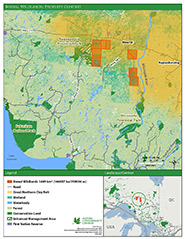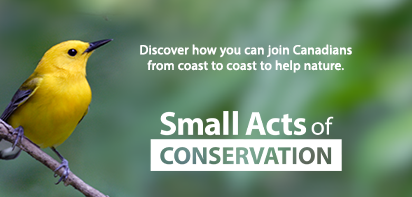Big, bold and boreal
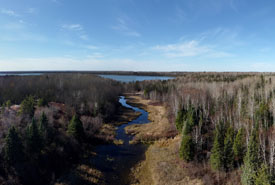
Boreal Wildlands, ON (Photo by NCC)
Boreal Wildlands
Part of Canada’s boreal forest, and known as the lungs of the Earth, the Boreal Wildlands helps defend our planet’s biodiversity and slow the effects of climate change on a global scale.
At more than twice the size of the city of Toronto, this is the largest private land conservation project in Canada’s history. In the heart of Ontario’s boreal forest, 1,450-square-kilometre area, known as the Boreal Wildlands is now permanently protected.
Boreal Wildlands features more than 1,300 kilometres of rivers and streams, vast carbon-storing peatlands and seemingly endless stretches of interior forest. Boreal Wildlands alone stores more than 192 million tonnes of CO2e, equivalent to the average lifetime emissions of 3 million cars, demonstrating the direct positive impact this site’s conservation could have on stemming the global climate and biodiversity crises.
Quick facts
- Location: Treaty 9 Territory, South of Hearst, Ontario
- Habitat type: Boreal forests, wetlands, rivers and creeks
- Size: 1,450 square kilometres (145,000 hectares)
- Species: Wide-ranging mammals, including black bear, moose, wolves and lynx. Rare birds, including Canada warbler, barn swallow and olive-sided flycatcher. Lake sturgeon are likely to be present in the rivers that flow to James Bay.
Get a birds-eye view of the Boreal Wildlands and discover how we can work together to slow climate change: borealwildlands.ca
At the Nature Conservancy of Canada, we acknowledge that the work we do across the country is on the traditional territories of many Indigenous Peoples. The Boreal Wildlands project is within Treaty 9 (James Bay Treaty) and is both the traditional and current homelands of many Indigenous Nations and communities. NCC is working to build meaningful, respectful and long-term relationships with local Indigenous communities that acknowledge and support the rights and connections of Indigenous Peoples to these lands.
The lungs of the Earth
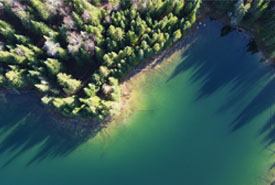
Boreal Wildlands, ON (Photo by NCC)
Canada’s boreal forest is often called “The Lungs of the Earth.” Spanning 300 million hectares, it is the Earth’s largest terrestrial carbon sink, has some of the most intact forest left on Earth, and provides habitat for countless species of plants and animals, including over 300 species of birds. Its deep peatlands capture and store carbon at the highest rates of any northern ecosystem. With threats to the boreal forest only growing as the climate changes, protecting these important lands is more critical than ever before. Landscape-scale conservation initiatives like the Boreal Wildlands project directly contribute to Canada’s commitments to conserve 30 per cent of our lands and waters by 2030.
An area under threat
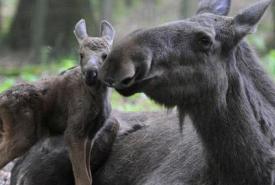
Moose and her calf (Photo courtesy of Wild for Wildlife and Nature)
This area of Northern Ontario faces threats, such as intensifying industrial development, aggressive logging and deforestation, and other human uses. Its protection provides the future of functional intact corridors for wide-ranging mammals, such as black bear and moose, as well as southern species that will be pushed northward due to climate change.
A natural legacy
When it comes to conserving Canada’s most important natural areas, acquiring land is just the beginning. Stewardship — managing the land for the long term — is at the heart of what we do. Each and every property we protect is monitored and managed so that the ecosystems are maintained and species thrive, even if that means leaving them be. This can include mapping and removing invasive species or restoring wetlands, grasslands and forests. It can also mean monitoring for species at risk, planting native species, building trails or installing signage.
To continue to care for the natural areas we protect, NCC has created a Stewardship Endowment Fund. This fund provides annual support for our priority stewardship work across Ontario. Annual benefits from the endowment fund are used to pay the costs necessary to ensure efficient and long-term, science-based management of lands under NCC’s care. NCC may explore and/or create carbon market-based mechanisms on new projects, like Boreal Wildlands, to help fund our conservation work.
NCC may direct all or a portion of gifts committed to this project to NCC’s Stewardship Endowment Fund for Ontario. Revenue generated by the Stewardship Endowment Fund provides support for long-term management on properties across the province, including NCC conservation lands in the Boreal Wildlands. In the event that this project becomes fully funded or cannot be carried out, your gift will be allocated to the next urgent priority in the Great Northern Clay Belt natural area.
Donations may be made by cheque, stock transfer or credit card through this link. Cheques should be made payable to “Nature Conservancy of Canada” and mailed to 1501-365 Bloor Street E, Toronto, ON M4W 3L4. Please indicate either in the memo portion of your cheque or in a note accompanying your donation that your gift is for “Great Northern Clay Belt – Boreal Wildlands.” If a U.S. tax deduction could be more advantageous, NCC works in partnership with a registered U.S. charity (American Friends of Canadian Nature) and we would be pleased to explore options with you.


